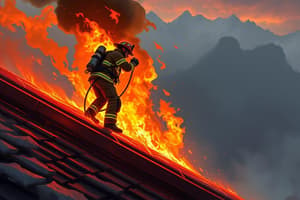Podcast
Questions and Answers
What does the term 'Take' refer to in fire management?
What does the term 'Take' refer to in fire management?
- To use the full reach of the stream (correct)
- To cool the burning materials
- To create high-pressure fronts
- To stop the production of heat
What is the significance of 'Make' space?
What is the significance of 'Make' space?
To stop the production of heat.
To gain control of a flowing handline means the fire reacts to us.
To gain control of a flowing handline means the fire reacts to us.
True (A)
What does 'Reach' refer to?
What does 'Reach' refer to?
What does water need to do to solid fuels according to fire management principles?
What does water need to do to solid fuels according to fire management principles?
What should be done as you move the handline?
What should be done as you move the handline?
The 'High-Low' technique involves attacking the upper register first in an inverted ___ motion.
The 'High-Low' technique involves attacking the upper register first in an inverted ___ motion.
Water should only be applied directly on what is burning during an incipient stage fire.
Water should only be applied directly on what is burning during an incipient stage fire.
What must happen for the benefits of gas contraction to be effective?
What must happen for the benefits of gas contraction to be effective?
What does 'Return' refer to in the context of water application?
What does 'Return' refer to in the context of water application?
What is LIFT in fire management?
What is LIFT in fire management?
Flashcards are hidden until you start studying
Study Notes
Nozzle Forward Triplets Overview
- Take: Utilizing the full reach of the stream enhances the environment ahead of the team by controlling temperature and pressure gradients. It creates survivable space by placing water between victims and firefighters.
- Make: Stopping heat production through cooling is essential to contract hot, toxic gases. Solid fuel gases must be physically cooled for effective compression.
- Control: A flowing handline should make the fire react to the firefighters, enabling the team to maintain control over the situation.
Water Application Techniques
- Reach: Water should be directed downrange, acting as the spearhead in firefighting efforts by ensuring that it reaches ahead of the firefighters.
- Coat: Solids are categorized as "battery materials" (which absorb heat and become ignition sources) or "burn materials" (which support combustion). Water must coat solid fuels to remove heat and prevent re-radiation of heat back into the environment.
Strategic Firefighting Actions
- Seal: Each space should be sealed off as the team progresses. A moving handline creates a high-pressure front, assisting in removing combustion products and introducing fresh air into the space. Aim to move combustion products away from interior exposures while using high-low and low applications of water.
- High-Low: Attack the upper sections first in an inverted "U" motion, followed by sweeping the floor to complete an "O" shape. This method is effective in stages beyond incipient fires.
- Low: Direct water application to the burning materials is suitable only for incipient stage fires, ensuring that it won't cause harm to anyone inside.
Environment Management
- Cooling: It's crucial to sufficiently cool the environment to benefit from gas contraction and terminate combustion. Prolonged flow is necessary for effective space control, while premature line shut-off can lead to hazards.
- Return: Achieve maximum water return at the floor level. Water must penetrate the thermal column effectively and fall back without vaporizing, while short bursts are ineffective for reliable diagnostics.
Lift and Ventilation
- Lift: Although beneficial, lift is not essential when the environment is cooled. It occurs as gases cool and contract, but its efficiency depends on factors like thermal balance, compartment size, and ventilation profile. A cool environment often leads to a more survivable situation.
Studying That Suits You
Use AI to generate personalized quizzes and flashcards to suit your learning preferences.



